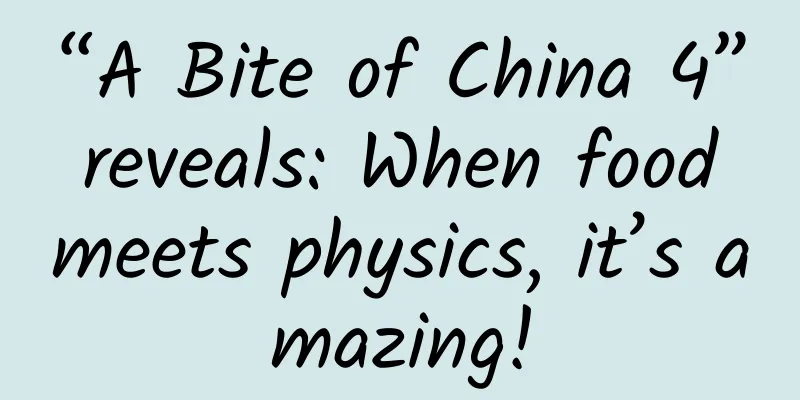“A Bite of China 4” reveals: When food meets physics, it’s amazing!

|
"A Bite of China" presents Chinese food culture from different angles, offering the audience a cultural feast that stimulates both the vision and the taste buds. It has become a cultural phenomenon that has attracted much attention in recent years. Food culture not only reflects the natural geography and customs of a place, but is also essentially a scientific phenomenon. Paying attention to the scientific elements in food culture will add a dimension to our understanding of Chinese food culture. Watching "A Bite of China" (Season 4) (hereinafter referred to as "A Bite of China 4") gave me the opportunity to understand some of the mysteries of gastronomy from the perspective of physics. In today's technologically advanced era, paying attention to the scientific elements in food culture is conducive to the dissemination, inheritance and development of food culture. How is heat transferred to food? To make raw food into cooked food is generally speaking to heat the food. However, different factors need to be considered and different implementation methods will eventually lead to different food production methods. The production methods and production facilities shown in Chinese food culture reflect the thorough understanding and full utilization of the scientific principles behind it by the Chinese working people. The ways of providing heat to food, considering only from the perspective of physical heat transfer media, include photon gas (blackbody radiation, monochromatic microwaves), solid thermal contact, liquid (water, oil) thermal contact, and gas (water vapor, combustion air, combustion oil and gas mixture) heat transfer, etc., and sometimes some clever combination. Blackbody radiation Is it a coincidence that the oven hearth is made black? Take the oven for baking buns and sesame cakes as an example. The furnace emits a wide spectrum of electromagnetic radiation that is close to blackbody radiation (the walls of a good oven are black, that is not a coincidence). This thermal radiation is absorbed by the water in the food, making the food cooked. Due to the diffuse scattering characteristics of blackbody radiation, the exposed part of the buns or pancakes facing the furnace will be cooked evenly (see "Tip of the Tongue 4" "Special Skills", large furnace pancakes). At the same time, the bottom of the pasta attached to the wall is heated by the hot furnace wall through mechanical vibration. Once bubbles are generated in the pasta, the heat transfer surface will be uneven, resulting in poor baking effect. Modern microwave ovens use single-frequency electromagnetic waves (2.45GHz). When electromagnetic waves are absorbed by water, they will cause temperature rise, so microwave ovens are more suitable for heating water-containing foods. Heat transfer in solids Why do we add sand when frying peanuts? The most obvious way to show the problem of solid heat transfer is frying, such as frying peanuts, chestnuts, and Chinese torreya grandis in a large pot. The disadvantage of this heat transfer method is that the contact between the frying nuts and the pot is almost point-type, which will cause extremely uneven heat transfer. The wisdom of the Chinese working people lies in adding solid particles such as sand, iron filings, and salt into the pot to form a three-dimensional heat-conducting fluid, so that peanuts, chestnuts, and Chinese torreya can be in surface contact with these granular substances. Peanuts and other nuts will be fried more evenly, avoiding the problem of burning them (see "A Bite of China 4" "Heavenly Work", fried Chinese torreya). Liquid heat transfer Why fried food is crispy on the outside and tender on the inside The characteristics of liquid heat transfer are all-round contact and uniform heat transfer. The most common cooking method is boiling. Under normal pressure, the boiling point of water does not exceed 100°C. For the preparation of some foods, this temperature may be too low, and high-boiling-point liquids such as oil can provide a higher temperature. The large temperature difference between the hot oil and the food can achieve extremely fast heat transfer. This heating method can make the food crispy on the outside and tender on the inside, which is particularly suitable for the preparation of fish and meat products (see "Tip of the Tongue 4" "Special Skills", vinegar fish). Since the temperature of the hot oil is much higher than the boiling point of water, the water will quickly boil and vaporize, producing a "frying" effect. In this process, the food is actually steamed more by the evaporation of its internal water. High-temperature oil-water mixed steam is flammable, which provides a special type of high-temperature medium, allowing cooking methods such as stir-frying to keep the food full and tender (see "A Bite of China 4" "Unique Skills", stir-fried kidney). Mixed Heat Transfer Why does bacon taste better after being smoked? Fire is a mixed heat transfer medium, including broad-spectrum light and high-temperature gas. Food preparation methods using fire include grilling and smoking, which are very ancient methods (see "Tip of the Tongue 4" "Dongtian", Fire Pond). As a carrier, flames have a strong transport capacity and can carry the aroma of wood or the flavors of spices such as chili peppers into meat products (see "A Bite of China 4" "Huan Fa", smoked bacon; "A Bite of China 4" "Fireworks", roasted black pig; "A Bite of China 4" "Feng Wu", charcoal-grilled crabs), giving smoked food a unique flavor. High temperature steam Steaming can preserve the original flavor High-temperature steam cooking uses the characteristic that water vapor fills the entire space including the inside of the food, making it easy for the food to be cooked evenly. This is especially suitable for food with open surfaces and pores. In addition, steam at room temperature and pressure has a very poor solubility, which helps to preserve the original flavor of food. Therefore, steaming is a particularly common way of preparing food (see "Tip of the Tongue 4" "Scenery", Steamed Dishes). When a closed container is heated, the steam pressure will increase as the temperature rises; when the container is quickly depressurized, the gas in the food will rush outward, creating a popcorn-like effect. Different ingredients have different heat conduction Why do we need to dig out the eyes of steamed bread? The factor that determines the food production process is the food itself. The material composition, structural form, thermal conductivity, and dynamic effects of heating on the food itself will be considered in different production methods. Those production methods that are ultimately effective are all scientific. Let's take two examples. Steamed cornbread uses high-temperature steam to enter the dough to cook the food. Due to the cone-shaped geometry of the cornbread, the depth is different from its surface. In order to steam the cornbread as synchronously as possible, a hole is cut at the bottom of the cornbread. For pancakes, if the dough is heated from one side, it is likely that the inside will still be raw. Fold the dough into multiple layers, use air interlayers to partially block the heat conduction, and steam it from the inside, so that it will be crispy on the outside and tender on the inside (see "A Bite of China 4" "Heavenly Crepe", crispy pancakes). Controlling the temperature of water-containing substances creates different flavors Water is a key ingredient in all kinds of food, so it can be said that understanding the physical properties of water is the key to understanding the art of cooking. Add cold water to boil dumplings to cool the internal water vapor Water absorbs almost the entire spectrum of electromagnetic waves. This is the fundamental reason why food can be cooked by various heating methods, and it is also the fundamental reason why chefs should pay special attention to the factor of water. When steaming or frying food, the trapped water vapor makes the average specific gravity of the food lower than that of water or oil, so the food will float up. If not intervened, it will become undercooked. This problem will occur when boiling dumplings. It is recommended to add cold water when boiling dumplings, in order to cool the water vapor inside the dumplings and allow the dumplings to be fully submerged in water and cooked thoroughly (see "Tip of the Tongue 4" "Chinese Style", Boiling Dumplings). Water that is “locked” with food needs to be “treated” differently Water is a universal solvent and can be heated to 100°C under normal pressure, which is the key to its ability to dissolve nutrients in foods such as bones and nuts. Therefore, making soup is a major branch of the art of cooking, and it is full of wonderful things. High-pressure and high-temperature water vapor will have a great dissolving power. For foods that need to dissolve nutrients, using high-pressure steam is the right choice, such as steamed chicken. On the other hand, when frying or grilling, how to keep the moisture in the food becomes a problem. An interesting strategy is to add a protective layer. This strategy is used when coating food with batter when frying or coating beggar's chicken with mud. It should be noted that in order to form a closed shell, the initial temperature must be high enough to allow the batter or mud on the outside to solidify quickly and form a protective layer. Since the protective layer has poor thermal conductivity, the moisture in the protective layer can be turned into steam due to the high temperature, which can steam the food, making the food very tender. A word of caution, for some foods that easily form a dense protective layer, such as fried beef balls, the air pressure inside may be higher than the external atmospheric pressure even after cooling. Once the shell is bitten, the juice will spray out from the inside, so be careful when eating. In addition, water expands by about 10% when it freezes. When water enters cells and freezes, it will puncture the cells of plants and animals. This is not good for preserving fruits, but for some meats that are used for frying, you may want to take advantage of this property of water (see "Tip of the Tongue 4" "Huan Fa", frozen meat collection). Let the meat absorb enough water, cool it down to freeze, and then coat it with batter and fry it. The meat will taste softer. The art of food preparation is full of science. A Bite of China presents the food culture of different places to the public. It would be a pity if we only enjoy it for the visual and taste buds. I would like to emphasize that A Bite of China can also provide excellent basic physics education materials, which is probably something the creators did not expect at the beginning. (The author Cao Zexian is a researcher at the Institute of Physics, Chinese Academy of Sciences) |
Recommend
From 0-1 to build operational live broadcast training: anchor foundation, mentality shaping, ability training to live broadcast rhythm, speech skills
From 0-1, we will build operational live streamin...
It’s confirmed! Launch will take place at 9:31 a.m. tomorrow, and the astronaut crew has been announced!
On May 29, the China Manned Space Engineering Off...
The 120,000 yuan Camry put Toyota on the hot search, but pulled Japanese cars off the altar
Every manufacturer wants to be on the hot search....
Operational promotion: 4 general methods and techniques to increase followers!
Today, we will share 4 general tips for increasin...
Electric Technology Car News: BYD's new car M5 debuts. When will the infighting independent MPVs be able to target joint ventures?
In China, MPVs used to be business models, and we...
Sichuan Hanyuan 4.8 magnitude earthquake! Transfer! An effective guide to escape and self-rescue in case of an earthquake
According to the official measurement of the Chin...
Newbie on the road: How do I do my operations work?
The daily operation of an Internet company is the...
After studying the 5 subway screen-swiping incidents, I found an interesting thing
The subway is very busy this year and is often po...
Alipay releases 10-year reconciliation statement: "Small city" phenomenon reflects consumption trends
On December 8, Alipay, a subsidiary of Ant Financ...
How does Baijiahao self-media make money? How can a novice quickly become a regular employee and earn income?
In recent years, self-media has been booming, and...
This disease is widely hidden in the population, causing great harm, but few people know about it.
The cause of hypochondriasis is still unknown. Hi...
Can Alzheimer's disease be contagious? Five cases of medical transmission have been reported | Science and Technology Weekly
Compiled by Zhou Shuyi Can Alzheimer's diseas...
Born for smart home, ZIVOO smart box offers a comprehensive experience
The original intention of the TV box was to make ...
Seasonal changes on the tip of your tongue: Can you eat out-of-season fruits?
For a long time, people have had a subtle attitud...
This may be the most down-to-earth and clearest way to write an operation plan!
Friends who do operations will know that there wi...









